第5章1、2矩形谐振腔
- 格式:pdf
- 大小:622.92 KB
- 文档页数:35
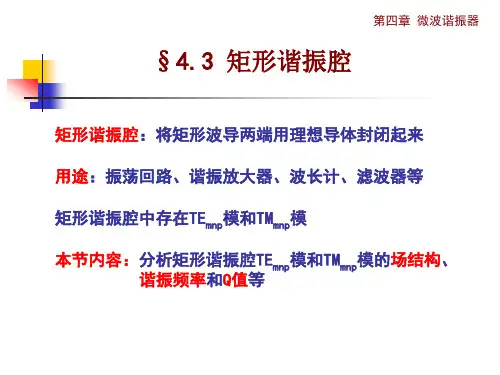
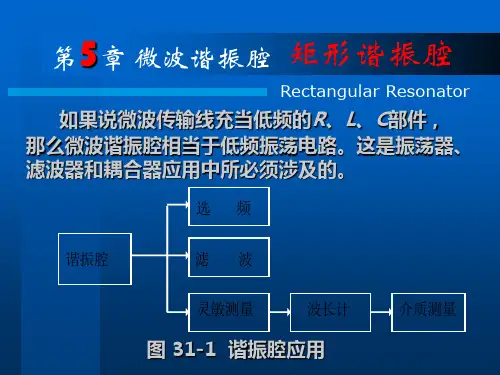
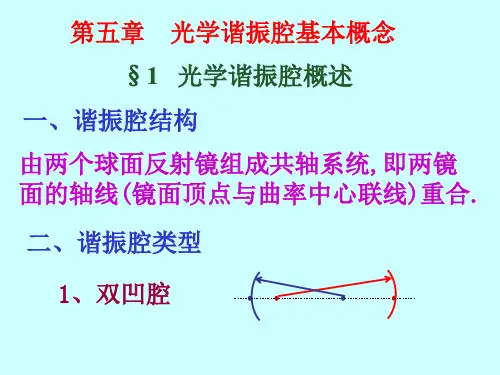

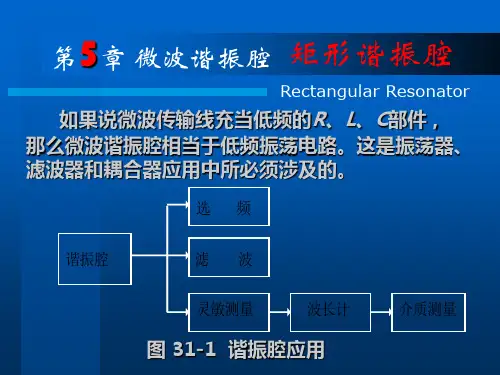
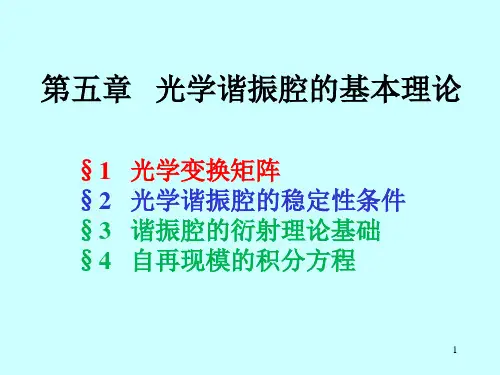

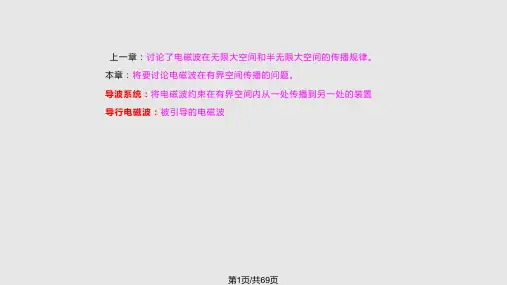
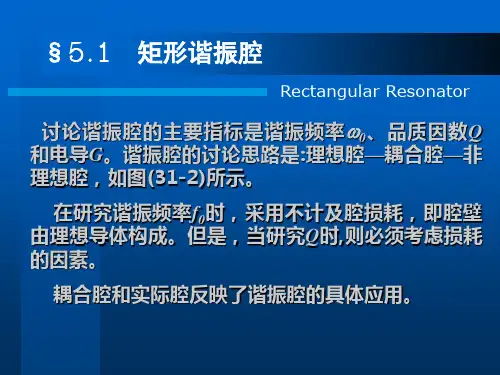
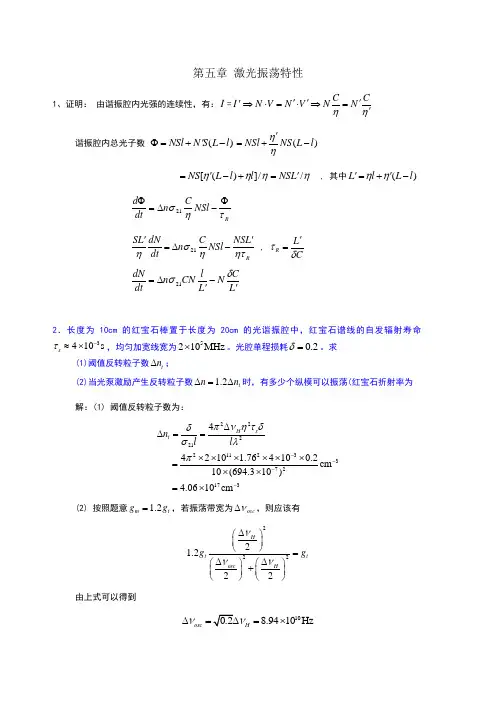
第五章 激光振荡特性1、证明: 由谐振腔内光强的连续性,有:I =I 'ηη''=⇒'⋅'=⋅⇒C N CNV N V N 谐振腔内总光子数 )(l L S N NSl -'+=Φ)(l L NS NSl -'+=ηη ηηη/])([l l L NS +-'=η/L NS '= , 其中)(l L l L -'+='ηηRNSl C n dt d τησΦ-∆=Φ21 R L NS NSl C n dt dN L S ητηση'-∆='21 , CL R δτ'=L CNL l CN n dt dN '-'∆=δσ212.长度为10cm 的红宝石棒置于长度为20cm 的光谐振腔中,红宝石谱线的自发辐射寿命3410s s τ-≈⨯,均匀加宽线宽为5210MHz ⨯。
光腔单程损耗0.2δ=。
求(1)阈值反转粒子数t n ∆;(2)当光泵激励产生反转粒子数 1.2t n n ∆=∆时,有多少个纵模可以振荡(红宝石折射率为 解:(1) 阈值反转粒子数为:222212112337217344210 1.764100.2 cm 10(694.310) 4.0610cm H s t n l l πνητδδσλπ----∆∆==⨯⨯⨯⨯⨯⨯=⨯⨯=⨯(2) 按照题意 1.2m t g g =,若振荡带宽为osc ν∆,则应该有22221.222H t t osc H g g ννν∆⎛⎫ ⎪⎝⎭=∆∆⎛⎫⎛⎫+⎪ ⎪⎝⎭⎝⎭ 由上式可以得到108.9410Hz osc H νν∆==⨯相邻纵模频率间隔为10831022( 1.76())2(10 1.7610) 5.4310Hzq c c l l L l ν⨯∆==='⨯+-⨯+=⨯ 所以1088.9410164.65.4310osc q νν∆⨯==∆⨯ 所以有164~165个纵模可以起振。
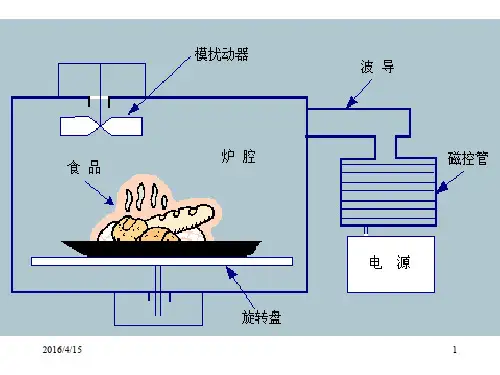
毕业论文二0一一年六月微波谐振腔特性参数的计算和仿真专业班级:通信工程3班姓名:指导教师:摘要微波谐振腔其内部的电磁场分布在空间三个坐标方向上都将受到限制,均成驻波分布.微波谐振腔在微波电路中起着与低频LC振荡回路相同的作用,是一种具有储能和选频特性的谐振器件.这次主要研究矩形谐振腔和圆柱体谐振腔的特性参数的计算和仿真.计算时用VC++中的MFC编写一个小界面计算工具,当输入变量参数时,类似计算器形式直接输出计算结果,仿真所用软件为HFSS,对矩形谐振腔和圆柱谐振腔进行仿真,输入变量得出仿真结果并与上述结算结果进行比较。
本文首先介绍了微波谐振腔的发展及前景和理论基础知识和MFC,Hfss等软件.然后分别进行了:1.对金属谐振腔中特性参数的特性及计算方式进行深入探讨,学习其基本特性与基本分析方法。
2.矩形谐振腔和圆柱谐振腔特性参数的计算在小界面计算方式方式下表示,并举例输入变量得出计算结果。
3.用Hfss微波技术仿真软件对矩形谐振腔和圆柱谐振腔仿真,与之前的结果进行比较。
4.在小界面计算工具在输入不同尺寸,内部填充不同材料,以及用铜,铁,铝等材料作为谐振腔表面材料等多种情况下计算,得出不同结果,并用仿真软件对矩形及圆柱谐振腔仿真,两组数据比较并得出结果。
本文主要研究金属谐振腔中矩形谐振腔及圆柱谐振腔特性参数的特性及计算方法,对其特性参数的特点,计算方式进行深入研究,然后运用编程软件对其编程,得到一个便捷的计算工具,并对矩形及圆柱谐振腔仿真,计算结果与仿真结果比较来判别计算工具的实用性与便捷性。
关键词:金属谐振腔,特性参数,MFC,小界面,Hfss,仿真AbstractMicrowave resonant cavity of internal electromagnetic field distribution in space three coordinate direction will be limited, all into standing wave distribution. Microwave resonator in microwave circuits plays and low frequency oscillation loop of the same role LC, is one kind has the energy storage and choose the resonance frequency characteristics of the device. The main research rectangular resonant cavity and cylinder of resonance cavity characteristic parameters of the calculation and simulation calculation with vc + +. When the MFC write a small interface calculation tool, when the input variable parameter, similar calculator form output calculation result directly, and the simulation software for HFSS, used for rectangular resonant cavity and cylindrical a rectangular resonant cavity simulation, the input variables that the simulation results and the results were compared with the settlement. This paper first introduces the development of microwave resonator and prospects and theoretical knowledge and MFC, Hfss and software. And then, the:1. To metal in a resonant cavity characteristic parameters of the characteristics and calculation way further discusses the basic characteristics and learning basic analysis method.2. Rectangular resonant cavity and cylindrical resonator parameters calculation in small interface calculated method, and an example is said that the calculation results input variables.3. With Hfss microwave technology simulation software of the rectangular resonant cavity and cylindrical resonant cavity, and the results of the simulation before the comparison.4. In a small interface computing tools in different size, internal filling input, and different material with copper, iron, aluminum and other materials as a resonant cavity surface material, etc cases calculated, different results, and the simulation software of the rectangular cylinder and resonant cavity simulation, two sets of data and compared to obtain the result.This paper makes a study of the metal in a resonant cavity rectangular resonant cavity and cylindrical resonator characteristic parameters of the characteristics and calculation method, and the characteristic parameters of the method for calculating the characteristics, further research and study, and then use of its programming software programming, get a convenient calculation tool, and in rectangular cylinder and resonant cavity simulation, the results and simulation results is discrimination computing tools of practicality and convenience.Keywords:metal resonator, characteristic parameters, MFC, small interface, Hfss,目录第1章绪论 (1)1.1研究背景及概况 (1)1.2谐振腔的发展和应用 (2)1.3本文主要的工作 (3)第2章微波谐振腔的基本理论 (4)2.1 引言 (4)2.2 谐振频率f0的概念与计算方法 (5)2.3 品质因数Q的概念与计算方法 (7)第3章:金属波导型谐振腔 (10)3.1 矩形谐振腔 (10)3.1.1 矩形谐振腔谐振频率f0的计算方法 (13)3.1.2 矩形谐振腔品质因数Q的计算方法 (13)3.2 圆柱谐振腔 (15)第3章微波谐振腔特性参数的计算 (18)4.1 关于MFC (18)4.2 运用MFC进行编写的具体步骤 (18)4.2.1 对矩形腔编程 (19)4.2.2 对圆柱腔编程 (20)4.3 具体数据代入计算 (21)第5章微波谐振腔的仿真 (23)5.1 电磁仿真软件ANSOFT HFSS (23)5.2谐振腔的的仿真步骤 (24)5.2.1 矩形谐振腔的的仿真步骤 (24)5.2.2 圆柱谐振腔的的仿真步骤 (26)5.3 对实验结果进行分析 (27)第6章:总结 (31)参考文献 (32)致谢 (33)微波谐振腔特性参数的计算和仿真第1章绪论1.1研究背景及概况目前,随着移动通信,卫星通信的迅速发展,和通讯设备的进一步向多功能,便携化,全数字化和高集成化方向发展,极大地推动了电子元器件的小型化,片式化和低成本化,以及其间组合化,功能集成化的发展进程。